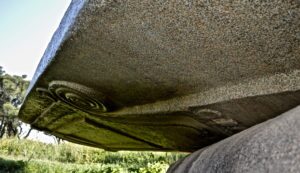
Most visitors to Aksum, Ethiopia’s 2,000-year-old capital, glimpse little of its past glory. It is estimated that over 95% of this city’s classical wonders still lie buried beneath the desolation of centuries past or languish, neglected by the more pressing demands of an emerging nation. Tourists are regularly shown a few stelae, or standing stones, some secondary-use royal tombs, and the small 7th century AD/CE Dungur villa purporting to be the palace of the Queen of Sheba (11th-10th cent. BC/BCE). The common practice of guides simply repeating fabricated myths with little grounding in archaeological or historical-geographical contexts leaves most tourists disappointed, perplexed, and cynical as they were promised one of the largest and longest-lived empires in Africa.
This, hopefully, is changing.
_____________________________
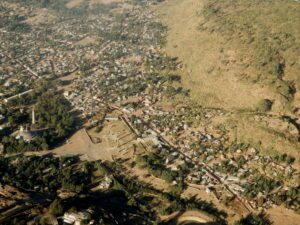
Fig. 1 – Aerial view of Aksum with Old Town (top left) and the Stelae Field in central foreground. Photo is taken to the west-northwest. (Photo SCW- 2013).
_____________________________
As an archaeologist born and raised in East Africa, I was invited to set up the Master’s program for Archaeology and Heritage at Aksum University in April 2012. I was enthusiastic at the prospect. During my year and a half tenure in the region, no day was ever routine. Surveying the buried old town and its immediate surroundings daily tantalized me with just enough secrets to keep me coming back for more. With every footfall, the very ground seemed to reverberate and writhe under the labor pains of this heritage’s sheer will to be re-born. That, sadly, was not to be. As with so many academic efforts over the past decades, Aksum’s amazing archaeological investigation along with its tourism opportunities were held hostage by regional bureaucratic obstacles, unfounded rumors, and orchestrated misinformation. That has yet to change.
For many and varied reasons, little archaeology has been permitted in Aksum. The reports from the 1906 Deutsche Aksum-Expedition (published 1913) still serve as the definitive archaeological work for Aksum, yet all four volumes, printed in German, are still not available in English or Amharic. Aksum has seen two other more modern excavations in 1972-74 by Dr. Chittick and in 1994-97 with Prof. David Phillipson, along with a few heritage-related smatterings related more to salvage excavations than modern scientific inquiry. Subsequently, an entire generation of Ethiopian cultural resource professionals and archaeologists has been denied thorough training in field management skills or direct access to this remarkable heritage, limiting the brilliant story Aksum can tell.
The long-term negative impacts of preventing young Ethiopian scholars from accessing their heritage in meaningful ways has created a generational gap in field-based capacities, experienced researchers, and published academicians. The short-sighted practice of allowing only outside academic PhDs to excavate continues to hamper field-training along with curtailing awareness of the full range of the phased approach to archaeology.
The decades of negligence by political appointees, however, can quickly be remedied, but it will take courage and integrity from the new leadership, along with a concerted effort and thoughtful, deliberate, field-intensive instruction. It will also require a new model for implementing best practices and modern cultural resource management principles. It is hoped with new leadership and competent authorities we will begin to address the many shortcoming of the previous regime. These decades of inattention, however, have also taken a remarkably tragic toll on existing heritages, not only in Aksum, but across the nation.
_____________________________

Fig. 2 – Image of the Stelae Field from the Deutsche Aksum Expedition – 1906.
_______________________________
In terms of tourism, then, this also means that anyone who visited Aksum within the last four decades would see relatively the same sites, virtually untouched. The image above, over 100 years old, illustrates how little has changed since 1906. Outside of the chance discovery of a new Ezana inscription found while digging a house foundation in 1982, few new artifacts or information are available to tourists. Compare that to similarly archaeologically-rich countries such as Greece, Italy, Egypt, Israel, and Jordan. Every year these countries have multiple new sites and cultural materials for tourists to visit. Additionally, the public relations benefits of these discoveries counter much of the negative press these countries have to deal with. Ethiopia has so many positive stories to tell, but given the limited utilization of its heritage, those stories get buried by the negative press of civil unrest or internally displaced peoples. Hopefully, this too is beginning to change.
For well over a decade, the status of the steady and relentless decline of the main heritage and cultural resources associated with Aksum were documented and repeatedly reported by archaeologists like Drs. David and Laurel Phillipson, the late Dr. Fatovich, and more recently, by myself, to the appropriate authorities in Mekele, Tigrai’s capital, and Addis Ababa. In 2013-2014, working as Coordinator of the Master’s Program in Archaeology and Heritage-management at Aksum University, I revisited and updated those previous assessments, including further recommendations and discoveries. As of August, 2019, few if any of the recommendations from previous reports have been implemented, leading to a series of emergent crises.
A Collapsing Heritage
Due to multiple natural and human factors, aside from neglect, the condition of the two main standing stelae in Aksum (No. 2 and No. 3), now face a critical situation. Stela 2, taken during Italy’s brief occupation (1936-1941), was returned from Rome in 2005 and re-erected in its original position. Unfortunately, as is too often the case, engineers conducted their project without proper oversight or consultation of cultural resource or heritage management experts, let alone archaeologists. As such, the two meters thick foundation of Stela No. 2 is pushing downward, like a piston, upon the now-collapsing, waterlogged, underground chambers of the original structures.
Stela No. 3 is currently shifting, due to the added compression of the re-erection of Stela No. 2, which when secured, was fixed within a foundation of two meters thick of concrete. Prior to the re-installation of returned Stela No. 2, a sub-surface geo-physical survey was conducted in accordance with the requirements of UNESCO. This research identified layers of clayish soils, between 2 meters to 3.5 to 4 meters depth, atop the underlying layer of non-permeable basalt, a rock similar to the hill of Mai Qoho to the southeast. In antiquity, many subterranean shaft tombs and chambers were carved through the clays and into the softer volcanic matrix atop this basalt. Several of these tombs are associated with various stelae on the surface. The underlying clays, due to an inflow of water and a heightened water table (current cause unknown) are slowly being pushed out, away by the downward pressure of the newly added mass of Stela No. 2.
______________________________

Fig. 3 – Map of Aksum – Yellow lines represent ancient roads. The old town is to the lower left. The black and red squares are the chamber tombs of Emperor Kaleb and Gebre Maskel (7th cent. CE) reutilizing an elite structure from the classic period from the 2nd cent. CE.
_______________________________
Consequently, all nearby structures and sub-surface chambers, including the west mausoleum and the unexcavated east tomb, are under threat of collapse. Additionally, the huge concrete anchors holding Stela No.3 appear also to be moving. The staircase leading to the east chambers of the Mausoleum collapsed once already, and the reconstructed wall is again buckling and in danger of failing a second time. A heavy concrete slab-roof was also placed atop the Mausoleum, and the shifting clays upslope are pushing this concrete south, threatening to collapse the existing tomb chambers and south wall.
There is an immediate need to mitigate against the increasing possibility of the collapse of Stela No. 3, as this could lead not only to the destruction of the stela itself, but create a domino effect on close-by stelae and sub-surface chambers and unidentified underlying or unexcavated sites.
A more broad, long-term plan and set of recommendations must be developed by a team of professionally trained, local and international experts in archaeology, heritage management, conservation, etc. to work alongside engineers within various specialties, including, but not limited to soils, hydrology, civil, architectural, and geology, and thus begin to design a thorough data recovery plan to accurately and comprehensively address the whole stelae park and multiple associated sites neglected for years. Partners and local stake-holders should include those previously involved in work associated with Aksum archaeology, survey, conservation and assessment. The MoCT, along with the PM’s office, are mandated by the UNESCO convention to lead this project.
One of the most visible indicators of these negative effects relates to the structure of the 3rd-4th century CE Tomb of the Brick Arches, 80 meters to the east of Stela No. 3. For over a decade now, a serious rise of the water table within the tomb chambers, to over 60-80 cm of standing water even in the dry season, demonstrates a broader, ubiquitous problem. Currently a metal door is in place and the tomb is not accessible to the public. This standing water identifies the whole field as supersaturated and thus much of the cultural materials and chambers are subject to substantial degradation. If chambers begin to subside, sinkholes could cause further instability within the whole stelae park.
_____________________________
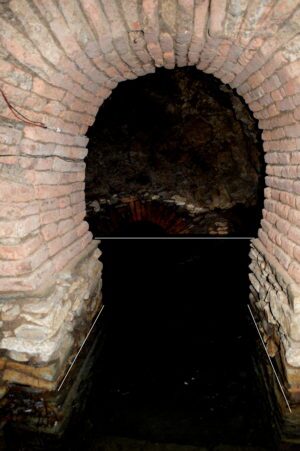
Fig. 4 – Tomb of the Brick Arches with over a meter of standing water within the sub-surface chambers. Note the white lines are the water surface. The back arch, covered in water over a meter high. (photo – SCW)
______________________________
Stela 3, the largest of the decorated standing stelae, was restrained during the re-erection of Stela No. 2 to secure it in place. It currently inclines slightly to the north-northeast. Like other stelae, this represents a multi-storied, elite-building. The heavy base plate exhibits an engraved vine decoration around the perimeter and bowls in the center. The entire structure surrounding the stela is built up, with a perimeter wall and steps from the main parking lot area. Two guyed cables currently support the stela. These were installed during the re-erection of Stela No. 2 to the west, and have yet to be removed pending further study and analysis of the consequence of removing them. The degree of inclination of Stela No. 3 has been checked by the cables for the last decade, but present an uglyfying aspect to the whole park.
____________________________
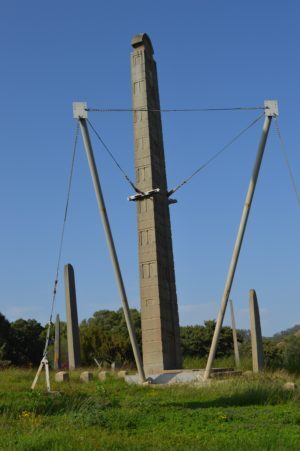
Fig. 5 – Stela No. 3 with decade-old truss and guyed cables holding it in place. Looking east. (photo – SCW)
___________________________
Over the last decade, the fabric truss holding the stela has been weakened by weather and UV from the sun, with no upkeep or proper analysis from previous authorities. Earlier recommendations demanded that funds immediately be set aside to study the feasibility of removing the guyed cables and adjusting the stela to either an upright position, or stabilizing it at its present inclination, including replacing the fabric. Unfortunately, past inactions have exacerbated the present situation, leaving now the radical alternative of actually laying Stela No. 3 down upon the ground until a proper analysis and permanent solution can be found. For obvious reasons, this solution would be highly unpopular, even if the most prudent.
Stela No. 4, a smaller, nearly identical stela to No. 3, lies prone in a northern direction near the current entrance of Enda Eyasu Church, where it was toppled during the Gudit wars of mid-tenth century CE. The cover plate is decorated in a similar fashion as Stela No. 3 and is still in place, if slightly lifted, with the other placement stones in situ. A mitigation excavation of Stela No. 4 would provide a Cultural Resource Management (CRM) team an analysis of the means of assessing the similar erection techniques and technology of Stela No. 3, and therefore provide a safe, proof-of-concept for properly addressing the critical factors facing Stela No. 3.
While conducting the analytical excavation of Stela No. 4, it would make sense to improve access to the other elements of the Stelae Field North. The apex of Stela No. 4, broken into two parts, has been removed to two separate locations. The uppermost part is in the Ezana Gardens park near the Telecom offices and the bottom section is in the church complex of the Fasilidas Mary of Zion church. This apex, containing unique features of two spear points and on the obverse, a shield, also has two circles from which two plaques were affixed. It would make touristic and research sense to bring the two disparate parts back together, placing them in the Aksum museum for proper viewing and safekeeping until Stela No. 4 could be restored fully.
Stela 5 is a decorated stela broken into six pieces and fallen in the river bed of Mai Miheja. Much of the stela is now completely covered by river deposits. Only the cover-plates and the lowest sections of this stela are visible.
Stela 6, similar to Stela 4, is collapsed and mostly intact, and therefore, a good candidate for further analysis. It is the 6th largest, and is decorated on its all sides with an Aksumite elite-structure building motif. Its double apex, fractured from the main body, is well preserved and in situ.
Stela 7 is intact and located at the northern end of the Enda Yesus church compound lying on top of the undecorated Stela 36, in a north to south direction. Stela 7 displays unique decorations with what has been referred to as a house decoration atop a stylized proto-Iolic or Ionic column. The underside decoration is visible to visitors only by laying prone on the ground or kneeling. There have been requests from the public and local authorities for the re-erection of this stela, as tradition stated that its re-erection will usher in a period of wealth and fortune to Aksum as the design is said to represent the symbol of the Ark of the Covenant. Until proper research is conducted and a thorough analysis of the whole area is conducted, it is ill-advised that any shift of status be attempted. Sadly, there are many other issues related to the long-term neglect of Aksum’s heritage, but none are as critical or emergent as the various stelae and monuments within the vicinity.
___________________________
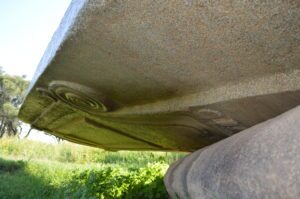
Fig. 6 – Stela No. 7 with unique proto-Ionic or –Aeolic capital design. Local tradition states this to be a representation of the chapel housing the Arc of the Covenant – (photo – SCW)
___________________________
Artifacts Reduced to Curiosities
Addressing the second critical lapse over the last decades relates to found-objects. A substantial component of any heritage management in any region relates to chance finds dug up during construction, road building, agriculture, etc. The persistent inexperience of how to manage found-objects is also a tragic consequence to the broader lack of proper field-intensive archaeological research and hands-on expertise as it relates to conservation and cultural resource management within local universities and among the various agencies and authorities.
Often while living in Aksum and conducting survey with my colleagues, farmers and priests proudly showed us many items plowed up from fields, or discovered while digging foundations, tombs, or latrines. For the most part, these simple ceramic vessels or figurines, coins, beads, or small metal objects constituted mere curiosities with marginal contextual archaeological value beyond site identification and possible chronologies. Many regional farmers and churches have baskets full of such finds which are often sold to tourists for a pittance.
_____________________________
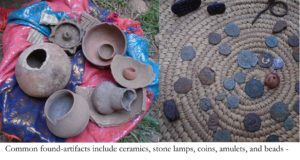
Fig. 7 – Cultural materials commonly found in fields are kept in rural churches. These ceramic vessels represent all periods of ancient Ethiopian history. The coins are from the last five centuries of the Aksumite Empire (end of the 3rd into the end of the 7th cent, CE). (photo – SCW)
_____________________________
One evening in September 2103, I received a somewhat frantic call from a merchant saying some farmers had brought in some special items and would I be able to assess them. What they had uncovered was a series of cast bronze plaques, and other cultural materials the likes of which were not even found in the museum. These included large cast-bronze/copper Ethio-Sabaean inscriptions (8th-5th cent. BCE), images of lions, humans, and winged sphinx, ceramic figurines and vessels, along with various small finds such as name-stamps, and inscribed stone amulets. I photographed what I could and immediately sent the images in e-mails to the former director of the Authority for Research and Conservation of Cultural Heritage (ARCCH) and the then-director of the Bureau of Culture and Tourism in Mekele, the state capital, asking them about the best way for them to take possession of these items.
The law as stated:
From Part Three in the PROCLAMATION NO 209/2000 A Proclamation to Provide for Research and Conservation of Cultural Heritage – 35 – Fortuitous Discovery of Cultural Heritage
1/ Any person who discovers any Cultural Heritage in the course of an excavation connected with mining explorations, building works, road construction or other similar activities or in the course of any other fortuitous event, shall forthwith report same to the Authority, and shall protect and keep same intact, until the Authority takes delivery thereof.
2/ The Authority shall upon a receipt of a report submitted pursuant to Sub-Article (1) hereof, take all appropriate measures to examine, take delivery of, and register the Cultural Heritage so discovered.
3/ Where the Authority fails to take, within six months, appropriate measures in accordance with Sub-Article (2) of this Article, the person who has discovered the Cultural Heritage may be released from his responsibility by submitting a written notification, with a full description of the situation, to the Regional government official.
4/ The Authority shall ensure that the appropriate reward is granted to a person who has handed over a Cultural Heritage discovered fortuitously in accordance with Sub-Articles (1) and (2) of this article. And such person shall be entitled to reimbursement, of expenses, if any, incurred in the course of discharging his duties under this Article.
There was little interest and only a tepid response. Surprised, I brought it up to our university department head. On the advice of local colleagues, they suggested we ask the merchant if we could take some of the smaller, early Ge’ez inscriptions out of the shop and, in the presence of two respected visiting archaeologists, brought them to the Culture and Tourism office in Aksum. We implored their office to take possession of them. We were told to return them to the merchant, since their source was unidentified and therefore knowledge related to their context was lost. As such, they were perceived to have little value. This level of lack of training or understanding of heritage is incomprehensible.
__________________________
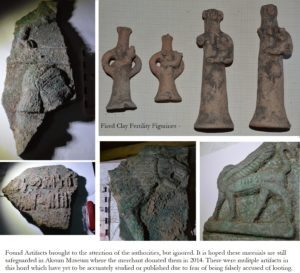
Fig. 8 – Montage of various found-artifacts from the Ethio-Sabaean period – (8th-5th cent. BCE). Top left, very rare depiction of a human face in profile; top right are fired clay fertility figurines; bottom left, cast Sabaean inscription, center, lion in profile, bottom right, winged sphinx with serpent tail. These photos were taken in a merchant’s shop and reported to the appropriate authorities at the time – 2104. (photo – SCW)
___________________________
Inscriptions are some of the most coveted finds in archaeology. Stunned, we returned all the artifacts to the shop owner and left it at that. When I had opportunity to personally meet with the authorities at the ARCCH or the Mekele Bureau of Culture and Tourism (BoCT), I inquired if anything had been done regarding the artifacts. I was told it was not in their purview and to leave it alone. Disheartened, I complied.
Strangely, six months on, using the very photographs I had sent to the authorities, the Reporter Amharic newspaper published an article, without verification or evidence, falsely accusing me of having looted the very objects I had brought to the attention of the authorities in the first place. The absurdity of these claims amply illustrated the lack of understanding, at the highest levels, of protocol related to found objects, heritage management and archaeology, let alone the stated law.
With little regard to the artifacts themselves, this quickly became a political football. When this story broke, the farmers and others with whom my university colleagues, including the Dean, had painstakingly been negotiating to transfer the materials to the museum, shied away and much of the cultural material was lost, destroyed, or reburied. According to regulation 4, the authorities apparently viewed as an appropriate reward for bringing these items to their attention, defamation of me and my colleagues and a continual retelling of their pathological nonsense. Ignoring the fact I came to Aksum on a fifth of my US salary and had reported and sent images to the authorities in the first place, the fabricated story of my looting the said objects became an easy out for the those charged with caring for, yet failed to secure them in the first place.
With over twenty years of field archaeology experience across three continents, never once has there been even a single accusation of impropriety. Imagine the irony incumbent within the framework that the only evidence they could muster to level such accusations stemmed from the fact I had reported these items in exact accordance with the law. Fortunately, despite this, and through immeasurable effort and courage, a few trusted colleagues and I were eventually able to convince the merchant to give the remaining valuable objects he had retained to the local Aksum museum for safe keeping. With my university colleague, a city representative, and the MoCT officer as witness, we deposited these items, where, I believe, they remain today in storage.
Had such accusations truly been about the artifacts, those finds could easily have been safeguarded when I initially informed the authorities. Five years on, no local authority has inquired of the museum about the finds, let alone researched or displayed them. Additionally, this falsehood remains the dominant narrative with current ARCCH authorities failing to verify any of these untruths or bothering to investigate the fiasco. This disconnect with reality is illustrated by the fact I am frequently tasked by the MoCT to conduct workshops and was requested to present as an expert at the National Conference for Strengthening Heritage Protection in Ethiopia by the Ministry of Culture and Tourism.
Sadly, this politically motivated debacle, with its subsequent loss of significant cultural materials, has been an all-too-common outcome for inadvertently discovered artifacts. This proves the need for new and clear protocols for addressing preservation of heritage with more open and directed communication between the respective authorities. For so many of my Ethiopian colleagues, the previous unqualified or corrupt political appointees created obstacles to the greater success of broader Ethiopian scholarship, leaving an unconscionable gap in professional training. This dogged fabrication has stolen five years of capacity and archaeological research from true Ethiopian scholars and Ethiopia’s future. Does this not deserve a thorough investigation? A related article can be found at https://www.ethiopia-insight.com/2018/11/07/aksums-true-glory-kept-under-wraps-by-fearful-bureaucracy/
Irrespective, these materials are here published for the first time. If they can still be found in the Aksum museum storage, it is my hope that with new, honest and intelligent leadership, these priceless, not-looted artifacts can actually be displayed and researched by a competent cohort of academics.
Ethiopia’s ongoing challenges regarding heritage management integrally relates directly to how the law concerning found-artifacts is written, or rather implemented. Does there currently exist no legal means for people in government to take possession of found items, even if freely given, without being defamed? Lessons can be learned from the experience of other countries. In the UK and many Scandinavian countries, found-items discovered in farming, building, road construction, etc. are compensated for by the state who therefore can legally take possession. This provides a very good model for ensuring especially valuable items, remain in-country for both research and presentation. It would serve Ethiopia’s long-term heritage interests to consider changing its current, but outdated law related to heritages. Today, many valuable, irreplaceable antiquities and artifacts, inadvertently excavated by farmers, builders, construction, etc. are still sold to tourists or the local antiquities dealer for a paltry sum or lay hidden in churches and homes across the country.
The Profession Dearth
A third major challenge Ethiopia faces is positively presenting its own heritage. With the growing body of skilled, committed, honest Ethiopian scholars, however, many projects, even at the university level, continue to be curtailed by the mismanagement or wrangling of a few politically appointed authorities. Whether it stems from extreme risk-aversion or a lack of clear procedures in working toward proper management or preservation of heritage, every delay sees further destruction of irreplaceable cultural material and sites, and lessens Ethiopia’s footing in launching a reputable and world-class tourism and heritage experience.
Ethiopia continues to rely almost exclusively upon outside academics, which has primarily benefited North American or European archaeologists or researchers. The primary focus of these scholars remains their own research leaving little capacity, time, or resources to adequately train Ethiopian counterparts. Thankfully, there are noted exceptions, however, even the few, field-trained, Ethiopian archaeologist working with these teams have had minimal engagement with the broader training and understanding of framing research questions, compiling desk-based analysis, or initiating comprehensive survey, let alone engaging in proper, current field management skills, formulating data recovery plans, conducting artifact analysis, or participating in full publications of excavations. Additionally, many of these outside scholars spend only a month in Ethiopia each year, exacerbating a knowledge gap in their own development of critical, applicable theories appropriate for Ethiopia’s and Africa’s unique data sets.
Academic PhDs have substantially far less field or excavation experience or expertise in field management skills and implementation than does a modern cultural resource management (CRM) specialist, let alone an entire CRM team. Yet, the ARCCH still relies solely upon such academic professionals. As a result, the vast majority of heritage or archaeological research conducted in Ethiopia over the previous decades has, therefore, focused almost exclusively upon externally driven agendas with questions, hypothesis, theories, or data sets derived from ‘Eurocentric’ academic models rather than indigenous, social-cultural interpretations of the data. Many Ethiopian scholars and their research questions are left out of the equation.
Imagine any other institution relying purely upon academics to facilitate practice. What would result if only physicians who taught in universities were allowed to practice medicine? As it is, a whole cadre of nurses, aides, certified nurse midwives, nurse practitioners, physicians, and other healthcare professionals daily care for the majority of health needs of a nation. Cultural resource management teams fulfil the same basic roles within most heritage and archaeological management issues across the globe. Yet even after decades of ARCCH approved archaeological research and excavations, Ethiopia possesses not a single Cultural Resource Management Team. Is it any wonder Ethiopia has so little to show from its astounding archaeological record and heritage corpus? Ethiopia still gleans comparatively few copper coins from tourism while it sits atop a veritable mountain of heritage gold.
This heavy-reliance on academic institutions indicates a tremendous ignorance of the shifts in the nature of global archaeological principles and best practices over the last four decades. By implementing this archaic model, Ethiopia continues to limit indigenous opportunity and lags far behind the majority of African and other developing nations in trained professionals across all fields related to heritage, cultural resource management, conservation, and tourism development. A more thorough analysis of this critical problem can be found at: https://www.ethiopia-insight.com/2018/10/29/ethiopia-must-overhaul-archaic-heritage-system-to-protect-ancient-treasures/
A Future in Waiting
Despite such challenges, I remain optimistic. During my time in Aksum, and many subsequent visits as part of my broader research, we have identified and/or recorded new sites from the Neolithic and Da’mat (5th – 2nd cent. BCE) periods, elite structures from both Early and Classic Aksumite periods (2nd – 6th cent. CE), a necropolis, and Portuguese fortifications (16th -17th cent.), along with an encampment of Emperor Yohannes IV (1870s). I am emboldened now, with the new leadership, to publish many of these finds, and to ask the current leadership to act boldly. All these and many other remarkable discoveries remain concealed, awaiting research.
Fortunately, even as many colleagues have moved on, we continue to plan and work toward obtaining official permits for opening up the ground for proper archaeological field excavation and training in excavation and cultural resource management skills. In Tigrai, that may still be decades off. But within other regions, it is hoped that the new authorities will find the courage and integrity to clear my name and we can all get back to the business of training field-management personnel to enhance Ethiopian capacity in cultural resource management skills.
With properly trained, competent public servants in the emerging heritage and tourism sector, Ethiopia’s cadre of new archaeologists and heritage and cultural resource management specialists will be successful in preserving and presenting Ethiopia’s rich and deep heritage. I envision the next wave of exploration, discovery, and excavation under the skillful hands and careful eyes of these trustworthy Ethiopian archaeologists and technicians. Of course, this is dependent upon the resoluteness and honesty of good people to stand against the autocratic and debilitating misinformation and obstructions of the past.
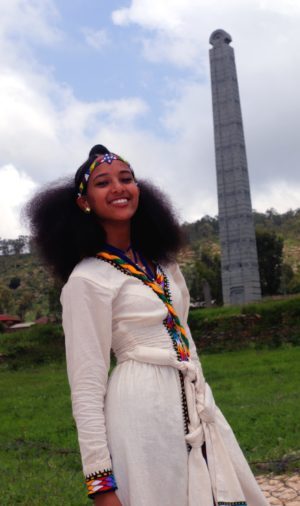
Young Ethiopian model in front of the Stelae Field (Stela No. 2) where there is rightfully much national pride related to heritage. – (photo – SCW)
Meanwhile, along with my colleagues, a veritable panoply of scholars wait. And so does a young girl sitting in the shade of the returned ancient stela in the Stelae Park, beginning to learn what it means that she is offspring of the most powerful empire sub-Saharan Africa has ever known. And herein remains the dream—this child, and so many like her, resting in the shadow of her heritage, may soon learn to apprehend her heritage in authentic ways. She will continue to visualize her emerging story of identity, as we carefully excavate and reveal this hidden, neglected jewel of ancient splendor. We will continue our research, hopeful, where our goal remains to transmit that specialized knowledge, expertise and experience of excavation and heritage management. Then, Ethiopia may sing again of her own ancient glories to the rest of the world.




